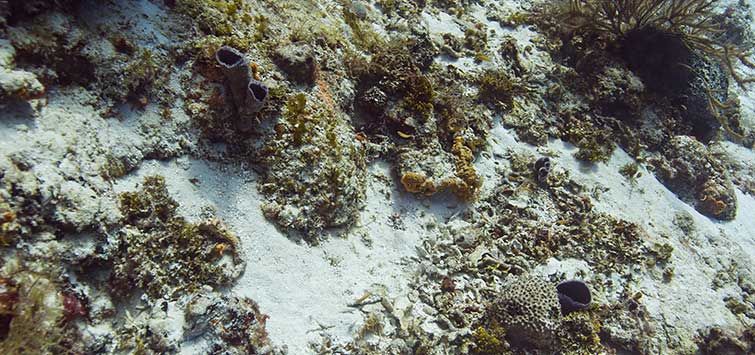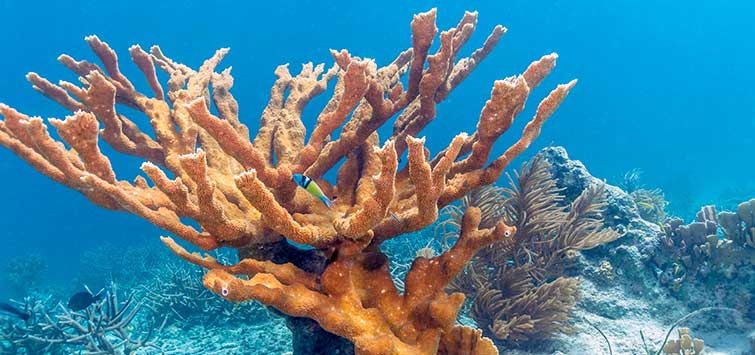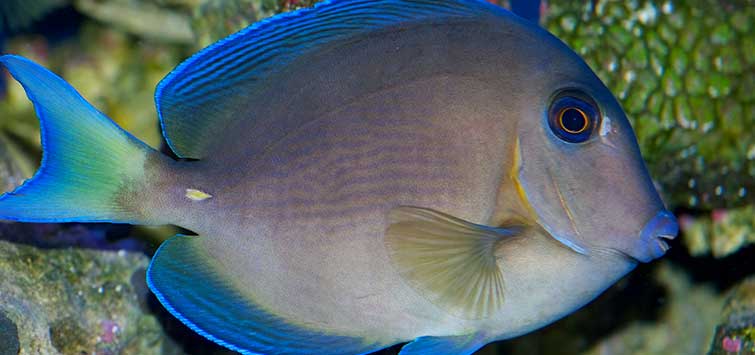Caribbean Reefs Under Stress
Author: Richard Aspinall
I’ve been very lucky not only to be able to write about reefs in captivity, but also fortunate to be able to visit reefs in the wild. Earlier this year, I visited the Windward Isles in the Southern Caribbean, spending time in the waters of Grenada and its smaller sister island of Carriacou. I thought it might be of interest to share some of my experiences with readers who might want to know more about the pressures faced by coral reefs in the region.
I’ve spent most of my diving time in the Indo-Pacific region, mainly in the coral-rich waters of the Red Sea. When I took my first dive in Caribbean waters, my initial thought was “where’s all the coral?”
Undergoing Changes
I knew that Acropora palmata, A. prolifera, and A. cervicornis had been reduced in coverage, but it wasn’t until I got back to my hotel and went on the internet that I fully understood why. According to NOAA, a number of factors had combined to reduce the range of corals, such as A. palmata, by as much as 95 percent since 1980. I hadn’t realized that such an important reef builder had been effectively deleted from a vast area. Clearly, the reefs that I was now visiting were not as they once were.
Although the reefs I was exploring were deeply fascinating and covered in a wealth of life, there were few examples of what I expected to see. On the forward reef slopes that would normally have been covered in Acropora, which provided habitat and shelter for a wealth of fish and invertebrate species, all I could find were species-poor rubble zones, with an occasional sandy patch in this area much approved of by several jawfish.
Lower current areas, where one might expect fewer acroporid corals, were overgrown with algae and a tangled mass of bryozoans, hydrozoans, and a complex mixture of sponges, associated polyps, and filter-feeding polychaetes. Among the barrel and vase sponges was a thick forest of various gorgonian species from across the octocoral grouping. They included Plexaura, Eunicea, Pterogorgia, Gorgonia, and so on. There were species from so many genera that my limited knowledge of this habitat was quickly exhausted.
Sea Life Up-Close
I found this habitat very attractive to the eye and quickly found myself focusing my camera on trumpetfish, filefish, and predatory conches that inhabited what I could only describe as an “animal forest.” Among the slow-moving fronds, I located some hard corals; brain and maze corals were quite noticeable and were often accompanied by small goby species that occupied me for several dives when I had a macro lens fitted.
The gobies fascinated me, as this was the first time I had seen them acting as cleaners. I also spent a great deal of time photographing arrow crabs and searching for the remarkably colored flamingo tongue snail (Cyphoma gibbosum), a relative of the cowry that can often be found at the base of octocorals grazing the flesh down to the hard supporting rod beneath.
Seeking a Diverse Environment
On my first few dives I witnessed a fairly diverse environment, but I wasn’t sure whether I was seeing the reefs as they ought to be. There were few fish families that I associated with coral reefs, such as polyp-feeding butterflyfishes and parrotfishes, though there were a good number of snappers and grunts. I was also privileged to see a fully grown pair of French angels (Pomacanthus paru) that regarded me with deep suspicion as they cruised past. I promised myself I’d encourage anyone thinking of acquiring a large angel that they must give it an awful lot of space.
I also fell in love with a fish I had never come across before, the Creole wrasse (Clepticus parrae). Found in huge numbers at several sites, the Creole wrasse is best described as a symphony of purple overwashed with warm colors.
As I returned to the dive boat, I noticed plenty of people fishing from the shore. I later asked around to find out what the locals were fishing for and, sure enough, they were fishing for anything, though parrotfishes were much in demand. A little research later informed me that parrotfishes were indeed in decline across the region, and their grazing habits were clearly being missed on the overgrown reefs. While there are some marine-protected areas in the Windward Isles, the ones I visited in the Grenada area were not funded or policed and may not have their designation renewed in the future.
Sea Urchins
The loss of grazing fishes alone might not be too detrimental to the reefs, but I was to learn that sea urchin numbers have also plummeted in the region after a disease outbreak in the mid-1980s. According to a National Academy of Sciences article by Nancy Knowlton: “By February 1984, the sea urchin had been virtually eliminated from all of its range, making this the most extensive and severe mass mortality ever reported for a marine organism.”
The long-spined sea urchin (Diadema antillarum) is a key species; but with the effective removal of the species, algae thrived and coral cover shrank across the Caribbean. This was aided in no small part by damage from hurricanes and other severe weather events that caused localized damage and sedimentation.
I have been told that the numbers of Diadema urchins are slowly rising. My dive guides showed me urchins within their “patch” where you could see the role the animals were playing in controlling encrusting algae and thus creating attachment sites for corals.
I was learning a lot on this trip, but what I really wanted to discover was if anything could be done about the situation, apart from the continued lobbying of decision makers to enforce legislation and to support fishermen making the transition to other livelihoods. Was there anything practical going on?
Artificial Reefs
While I was enjoying a few dives with Dive Grenada off Grand Anse Beach, I saw some strange concrete structures on the sand. I was told they were going to be turned into artificial reefs. I was lucky enough to join the team as the structures were taken out to a spot about 200 feet (60 meters) from the beach.
This was by no means easy to accomplish. To get the 6-foot- (2-meter-) tall concrete pyramids out to sea, the team had invented an unusual but effective transportation method. Each pyramid, which was resting on a plywood board atop runners, was towed down the beach by the dive boat. When the pyramid hit the water, the boat’s throttle was gunned, and I was amazed to see the pyramid water ski across the water until the skipper reached the agreed upon spot and cut the throttle. I’d never seen anything like it. Keen to see the next stage, I kitted up, grabbed my camera, and was ready to watch the team make the final adjustments to the new reefs’ positions and stability. The concrete pyramids sat in fifteen or so meters of water on the rubble of a once-thriving reef.
As I shot video of the newly sunken reefs, I explored others that had been sunk for a little less than a year only to find them already covered in life, from crinkle oysters to squat lobsters that were hiding in the blockwork. It was great to see several Diadema sea urchins, too. Admittedly, this is just a drop in the ocean (pun intended). Yet, if every dive center works to enrich its local habitats and educate tourists as well as locals, then the dive industry can become an effective force for change.
Lionfish
I’ve seen some of the threats that Caribbean reefs are facing and learned a little about how human activity—in terms of development, agricultural run-off, pollution, and overfishing—were combining with natural factors to threaten the delicate balances on the reefs. I’m also not forgetting the role coral disease has played in this sorry saga. However, I hadn’t yet witnessed a more insidious threat that can, with justification, be blamed on a limited number of aquarists: the plague of lionfish in the Caribbean.
As I understand it, lionfish in the Caribbean were seen as early as 1985, before Hurricane Andrew, which was said to have caused the release of several specimens from an aquarium. Genetic evidence suggests multiple sources for the current population, with specimens being released from private aquaria being the likely progenitors of a population that is, without natural predators, munching its way through the Caribbean.
To see the invasive species for myself, I teamed up with Deefer Diving on the island of Carriacou. The diving off Carriacou is a little wilder than from nearby Grenada, and I captured a great view of a gray nurse shark and spotted a few turtles among the octocorals and sponges.
Finding Lionfish
I’m familiar with lionfish, as I see them frequently in the Indo-Pacific and Red Sea. I always find it interesting trying to photograph what can be quite shy creatures despite their predatory nature. On this dive, though, it was a different story. I saw around half a dozen lionfish, mainly juveniles. Maybe I’m imagining it, but they seemed more skittish than usual. With reason perhaps; they are increasingly being caught by conservation-minded divers and very often later cooked in local restaurants.
[Editor’s Note: Some researchers feel a handful or even a small group of aquarists releasing lionfish couldn’t account for the population explosion that is currently taking place in wild Caribbean and Atlantic habitats. There are other possibilities that can explain their abundant numbers in Atlantic/Caribbean waters. One theory is that ships that travel into the lionfish’s natural range, then into Caribbean waters, dumped ballast water that may have carried juvenile lionfish. Another proposed explanation is that during hurricane events, when public aquariums were washed away in the storm, large numbers of lionfish were released into the sea.]
A Pleasant Surprise
I was to have one more surprise as we completed our safety stops to help limit the risk of the bends. I briefly caught a glimpse of what the Caribbean ought to be. For whatever reason—be it due to the tide, current, or geology—I was amidst a coral reef and, for the first time, surrounded by elkhorn colonies, several over a meter wide and full of health. Finally, on my last dive, I saw some healthy elkhorn coral (Acropora palmata). The elkhorn is listed as a threatened species under the US Endangered Species Act, making it illegal to sell, trade, or keep in private aquariums.
Thoughts on the Future
I left with mixed feelings, pondering what the future held. Will pollution, bleaching, runoff, disease, and overfishing continue to devastate the Caribbean? I don’t know, as this was my first visit, and I’m a long way from being an expert. Sadly, it seems to me that the future isn’t rosy.
References
Knowlton, Nancy, 2001. “Sea urchin recovery from mass mortality: New hope for Caribbean coral reefs?” Proc. Academy of the National Academy of Sciences. http://www.pnas.org/content/98/9/4822

.png?h=595&iar=0&w=2781&hash=5FD5E69473BCC22199FBFA2FB71B6033)



